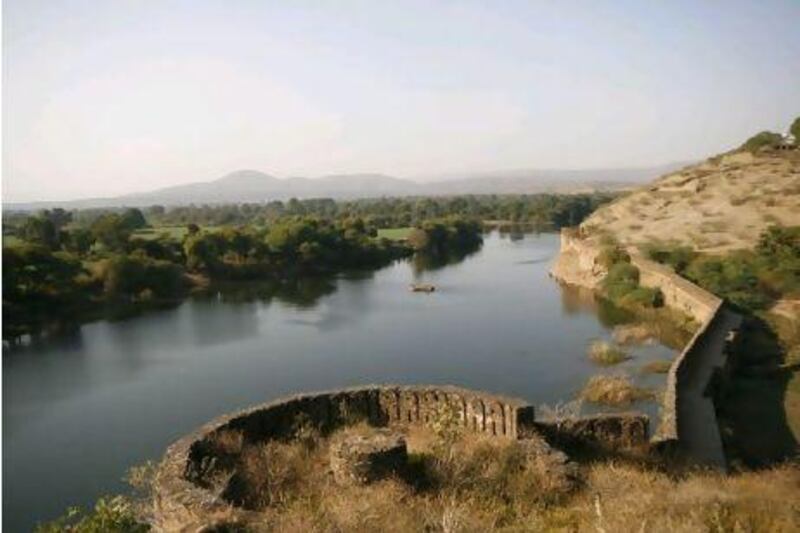Kumbalgarh and Ranakpur
Perched atop one of the loftiest parts of the Aravalli Hills, Kumbalgarh is the highest fort in Rajasthan. The Badal Mahal, or the Palace of Clouds, rises above it although you come rather more for the tranquil views than any architectural tour de force. Within the large fort stand clusters of disused Hindu temples and shrines along with a couple of small villages. Ignore all you’ll hear of the fort’s massive walls extending more than 30km: you can enjoy the Aravalli countryside by orbiting the entire site on these remarkable walls in a marvellous day-walk (it’s about 15km to 20km), during which the distant Badal Mahal often remains in view. Nearby Ranakpur boasts the Chaumukha Temple, a confection of intricately sculpted marble. Known for their sculptural prowess, this is one of the Jain faith’s most important and beautiful temples.
Where to stay Aodhi Hotel (www.hrhhotels.com; double rooms from 7,998 rupees [Dh593] per night) lies in the hills barely 2km from Kumbalgarh Fort. It’s a very comfortable modern hotel with some retro-styling, pleasant gardens and open spaces and a small pool. Ghanerao Royal Castle (www.ghaneraoroyalcastle.com, doubles from 3,780 rupees [Dh280] per night), located in Ghanerao village near Ranakpur, is a quirky place. Admittedly lacking the slickest service or particularly luxurious rooms, it does feel like you’ve dropped by to visit some low-key aristocratic relative. It’s particularly atmospheric if you happen to be the only guest.
Bundi and Bhainsrorgarh
Bundi, the former capital of a similarly-named princely state, is one of the nicest little towns in southern Rajasthan. On the hillside looming over its old quarter’s convoluted lanes stands Bundi Palace. For decades this extraordinary pile was officially closed to the public by the reclusive titular maharajah. Now it’s open and although the royal contents are long gone, it remains an extraordinary place to explore. On the plateau above stands Taragarh fort, with its semi-ruined buildings and step-wells, another wonderful place to visit with fine views across town. Farther south near Kota at the confluence of the Chambal and tiny Brahmani rivers lies Bhainsrorgarh. Still owned by the descendants of the ruling nobleman, the modest fort-palace stands atop a cliff overlooking the Chambal. A nearby dam ensures the river is always full. Clean and edged by farmland, there’s an almost European softness to the landscape.
Where to stay Bundi’s Haveli Braj Bhushanjee (www.kiplingsbundi.com, standard doubles at 6,300 rupees [Dh469] with breakfast) is one of the oldest hotels here, and stands just below the palace. Owned by the descendants of a family from which came several of Bundi’s prime ministers, there are some charming heritage touches and almost every room is different. Bhainsrorgarh Fort Hotel (www.bhainsrorgarh.com, suites only, from 12,500 rupees [Dh930], full board) is the only hotel here and is half the reason for coming. The owners strive for a “homely atmosphere” rather than luxury but you’ll still eat and sleep well.
Shekhawati
North of the state capital, Jaipur, stark and arid flatlands stretch to the horizon. Known as Shekhawati, this forbidding terrain hosts a cluster of small towns and villages that prospered in the 18th and 19th centuries from lucrative trade routes. Eventually, its canny merchants migrated to Raj-era commercial centres such as Mumbai and Kolkata and prospered further. Today, some of India's best-known industrialists have their roots here in Shekhawati. As fortunes rose, so did remittances to families left at home. This considerable wealth found expression in the construction of havelis, or courtyard mansions. Hundreds of these houses were beautifully decorated – inside and out – with murals and frescoes depicting mythological stories, religious episodes, scenes of everyday life and even inventions of the day. Today, this distinctive heritage – almost like an informal art gallery – survives in a peculiar limbo between respect and neglect. Some havelis stand empty and locked, while others are still inhabited by families or muddling-along caretakers. A few have been beautifully restored, many are slowly crumbling and a good selection can be visited either by entry ticket or simply by asking politely.
Where to stay Piramal Haveli (www.neemranahotels.com, double rooms from 2,000 [Dh148] per night) in Baggar village (near Jhunjhunnu) is a 1920s Euro-Rajput villa. Alsisar Mahal (www.alsisarmahal.com; double rooms from 5,888 rupees [Dh438], including breakfast) in Alsisar (also near Jhunjhunnu) is a beautifully restored section of a medieval fort.
Rural Marwar
Marwar is the old name for the princely state of Jodhpur, formerly one of Rajasthan’s most powerful kingdoms. For a so-called “desert state”, Rajasthan can be surprisingly green in the months immediately after the monsoon. The lakes and tanks are full, villagers are harvesting crops and in most well-watered regions there’s a quiet relative prosperity even as many agricultural methods remain unchanged for centuries. A handful of hotels make immersion not just practical but truly rewarding.
Where to stay Chhatra Sagar (www.chhatrasagar.com, doubles from 21,780 rupees [Dh1,616], includes all meals, soft drinks, sundowners and a village tour) near Nimaj offers luxury tents – room-sized with solid floors, beds with fine linen and slate bathrooms – atop a 19th-century dam. A beautiful lake, rich in birdlife, stretches away just yards from your guy-ropes. The property is restful with excellent food and its village walks provide an insight into rural life. Mihir Garh (www.mihirgarh.com; suites only from 14,500 rupees [Dh1,076], per night, full board) near Rohet and Jodhpur is a modern, faintly whimsical creation themed like a Rajput fortress (the name means “sun fort”). It has an infinity pool as well as individual plunge pools. Most striking are the stylish courtyards and open lounges. Fine, beautifully presented food completes the picture. Here, too, a village safari provides an insight into local life, particularly if you visit a traditional Bishnoi hamlet; for more than five centuries the Bishnoi have lived the ultimate “green” life; they refuse to cut trees and don’t cremate their dead.










